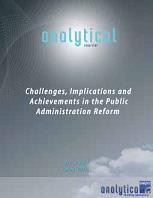A common indirect tax system in Bosnia and Herzegovina – continuing stalemate or a new chapter in sustainable federalism in Bosnia and Herzegovina?
A common indirect tax system in Bosnia and Herzegovina – continuing stalemate or a new chapter in sustainable federalism in Bosnia and Herzegovina?
Author(s): Samra Šuškić-BašićSubject(s): Economy
Published by: Аналитика Тинк-тенк Организација
Summary/Abstract: During the period from 2004 to 2006 Bosnia and Herzegovina made a significant step forward in its economic reforms by developing and establishing a single indirect taxation system, becoming one of 123 countries (Bird et al, 2001) around the world to adopt a value–added tax (VAT). This reform measure has brought about several key developments for Bosnia and Herzegovina. Firstly, the “selfcorrective” nature of VATs has enabled a boost in tax compliance, increasing the range of legal entities reporting on their business activities and paying taxes. Secondly, there has been a removal of tax from intermediate products, which is normally the case with retail sales taxes (RSTs), resulting in the expansion “of the tax base to include a wide range of services that, for the most part, were not subject to tax … thus [leading] to a considerable expansion in the range of consumption subject to tax” (Bird et al, 2001). For the budgets of the governments in Bosnia and Herzegovina this has lead to a surge in tax revenues on almost all levels (albeit temporarily, according to the International Monetary Fund – IMF estimates). Institutionally, the introduction of the VAT has lead to the merging of entity customs administrations into the Indirect Tax Authority (ITA), which is administered by the State of Bosnia and Herzegovina, thus centralizing the collection, recording and allocation of indirect taxes (which include VAT, excises and other import and export related surcharges). Most importantly, VAT has introduced an independent source of financing for the State institutions of Bosnia and Herzegovina which were, until then, dependent on contributions from the entity levels. However, progress achieved thus far in this very important reform, as well as in the overall system, risks being undermined. The current system of allocation of indirect taxes between the State, entities (The Federation of Bosnia and Herzegovina and Republika Srpska) and Brčko District governments is based on an assessment of relative proportion of final consumption, as reported by tax payers in tax returns. This basis for allocation and the way it is implemented in practice (via ad hoc decisions rather than standing regulations) is proving to be very problematic for several reasons, and has resulted in constant political disputes, tensions and dissatisfactions. During the Third Economic dialogues between the European Commission and Bosnia and Herzegovina held in Sarajevo on 17th October 2007, the (then) Chairman of the Managing Board of the ITA, Mr. Peter Nicoll, stressed this issue and stated that a permanent, or at least a more stable form of revenue allocation must be developed by the end of the year to avoid problems in year 3 in the implementation of the indirect tax system in Bosnia and Herzegovina.
Journal: Analytical
- Issue Year: 2010
- Issue No: 05
- Page Range: 65-86
- Page Count: 22
- Language: English

